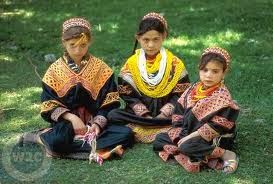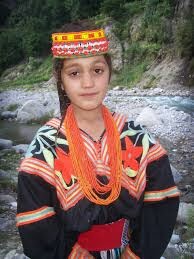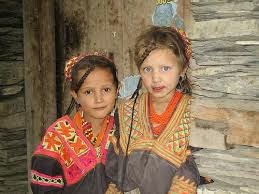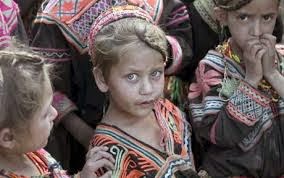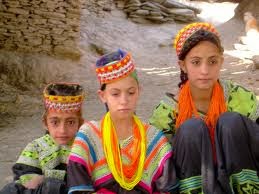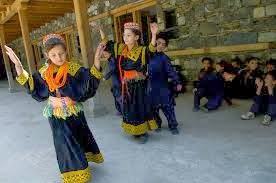Category Archives: Kalash people
The Kalasha
 |
| ‘Kalash girl’ (Kalash people live in the Kalash Valleys in Chitral, Khyber-Pakhtunkhwa, Pakistan) |
The Kalasha (Kalasha: Kaĺaśa, Nuristani: Kasivo) or Kalash, are a Dardic indigenous people residing in the Chitral District of Khyber-Pakhtunkhwa province of Pakistan. They speak the Kalasha language, from the Dardic family of the Indo-Iranian languages, and are considered a unique tribe among the Indo-Aryan peoples of Pakistan.[1]
The neighboring Nuristani people of the adjacent Nuristan (historically known as Kafiristan) province of Afghanistan once practiced the same polytheistic religion as the Kalash. However, by the late 19th century much of Nuristan had been converted to Islam, but the Kalasha of Chitral maintained their own separate cultural traditions.
The culture of Kalash people is unique and differs completely from the various ethnic groups surrounding them. They are polytheists and nature plays a highly significant and spiritual role in their daily life. As part of their religious tradition, sacrifices are offered and festivals held to give thanks for the abundant resources of their three valleys. Kalasha Desh (the three Kalash valleys) is made up of two distinct cultural areas, the valleys of Rumbur and Brumbret forming one and Birir valley the other, Birir valley being the most traditional of the two.[citation needed] Kalash mythology and folklore has been compared to that of ancient Greece,[2] but they are much closer to Indo-Iranian (Vedic and pre-Zoroastrian) traditions. This can be explained as Hellenic,Vedic and even roman traditions have a common indo-european root[3] Some of the Kalash people in their own traditions claim to be descendants of Alexander the Great’s soldiers,[4] however, extensive genetic testing has shown no connection.[5] The Kalash’s origins have fascinated anthropologists due to the unusually high frequency of light hair, skin, and eyes (particularly green). Some Pashtuns and Persians have been known to have blond hair or green eyes (such as Sharbat Gula).[6]
Language
Main article: Kalash language
The language of the Kalasha is a Dardic language, a sub-branch of the Indo-Iranian group, itself part of the larger Indo-European family. It is classified as a member of the Chitral sub-group, the only other member of that group being Khowar. Norwegian Linguist Georg Morgenstierne believes that in spite of similarities, Kalasha is an independent language in its own right and not a dialect of Khowar.[7][8] Currently about 5,000 people speak Kalasha and it is considered critically endangered by UNESCO.[9]
Location, climate and geography
Located in Khyber-Pakhtunkhwa, the Kalash people live in three isolated mountain valleys: Bumburet (Kalash: Mumuret), Rumbur (Rukmu), and Birir (Biriu). These valleys are opening towards the Kunar River, some 20 km south (downstream) of Chitral,
The Bumburet and Rumbur valleys join at
35°44′20″N 71°43′40″E / 35.73889°N 71.72778°E (1640 m), joining the Kunar at the village of Ayrun (
35°42′52″N 71°46′40″E / 35.71444°N 71.77778°E, 1400 m) and they each rise to passes connecting to Afghanistan’s Nuristan Province at about 4500 m.
The Birir valley opens towards the Kunar at the village of Gabhirat (
35°40′8″N 71°45′15″E / 35.66889°N 71.75417°E, 1360 m). A pass connects the Birir and Bumburet valleys at about 3000 m. The Kalash villages in all three valleys are located at a height of approximately 1900 to 2200 m.
The region is extremely fertile, covering the mountainside in rich oak forests and allowing for intensive agriculture, despite the fact that most of the work is done not by machinery, but by hand. The powerful and dangerous rivers that flow through the valleys have been harnessed to power grinding mills and to water the farm fields through the use of ingenious irrigation channels. Wheat, maize, grapes (generally used for wine), apples, apricots and walnuts are among the many foodstuffs grown in the area, along with surplus fodder used for feeding the livestock.[30]
The climate is typical of high elevation regions without large bodies of water to regulate the temperature. The summers are mild and agreeable with average maximum temperatures between 23° and 27 °C (73° – 81 °F). Winters, on the other hand, can be very cold, with average minimum temperatures between 2° and 1 °C (36° – 34 °F). The average yearly precipitation is 700 to 800 mm (28 – 32 inches).


